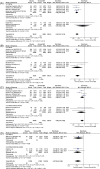The impact of underweight and obesity on outcomes in anticoagulated patients with atrial fibrillation: A systematic review and meta-analysis on the obesity paradox
- PMID: 33769583
- PMCID: PMC8119828
- DOI: 10.1002/clc.23593
The impact of underweight and obesity on outcomes in anticoagulated patients with atrial fibrillation: A systematic review and meta-analysis on the obesity paradox
Abstract
Although obesity is associated with the development and progression of atrial fibrillation (AF), an obesity paradox may be present, illustrated by seemingly protective effects of obesity on AF-related outcomes. Body mass index (BMI) has an impact on outcomes in AF patients using oral anticoagulants. After searching Medline and Embase, meta-analysis of results of four randomized and five observational studies demonstrated significantly lower risks of stroke or systemic embolism (RR 0.80, 95%CI [0.73-0.87]; RR 0.63, 95%CI [0.57-0.70]; and RR 0.42, 95%CI [0.31-0.57], respectively) and all-cause mortality (RR 0.73, 95%CI [0.64-0.83]; RR 0.61, 95%CI [0.52-0.71]; and RR 0.56, 95%CI [0.47-0.66], respectively) in overweight, obese and morbidly obese anticoagulated AF patients (BMI 25 to <30, ≥30 and ≥40 kg/m2 , respectively) compared to normal BMI anticoagulated AF patients (BMI 18.5 to <25 kg/m2 ). In contrast, thromboembolic (RR 1.92, 95%CI [1.28-2.90]) and mortality (RR 3.57, 95%CI [2.50-5.11]) risks were significantly increased in underweight anticoagulated AF patients (BMI <18.5 kg/m2 ). In overweight and obese anticoagulated AF patients, the risks of major bleeding (RR 0.86, 95%CI [0.76-0.99]; and RR 0.88, 95%CI [0.79-0.98], respectively) and intracranial bleeding (RR 0.75, 95%CI [0.58-0.97]; and RR 0.57, 95%CI [0.40-0.80], respectively) were also significantly lower compared to normal BMI patients, while similar risks were observed in underweight and morbidly obese patients. This meta-analysis demonstrated lower thromboembolic and mortality risks with increasing BMI. However, as this paradox was driven by results from randomized studies, while observational studies rendered more conflicting results, these seemingly protective effects should still be interpreted with caution.
Keywords: anticoagulants; atrial fibrillation; body mass index; meta-analysis; obesity; underweight.
© 2021 The Authors. Clinical Cardiology published by Wiley Periodicals LLC.
Figures




Similar articles
-
Non-Vitamin K Antagonist Oral Anticoagulants (NOACs) Versus Warfarin in Patients with Atrial Fibrillation and (Morbid) Obesity or Low Body Weight: a Systematic Review and Meta-Analysis.Cardiovasc Drugs Ther. 2022 Aug;36(4):749-761. doi: 10.1007/s10557-020-07122-6. Epub 2021 Jan 11. Cardiovasc Drugs Ther. 2022. PMID: 33428092
-
Efficacy and Safety of Direct Oral Anticoagulants Versus Warfarin in Patients with Atrial Fibrillation Across BMI Categories: A Systematic Review and Meta-Analysis.Am J Cardiovasc Drugs. 2020 Feb;20(1):51-60. doi: 10.1007/s40256-019-00362-4. Am J Cardiovasc Drugs. 2020. PMID: 31342343
-
Association between Body Mass Index and Clinical Outcomes in Patients with Non-valvular Atrial Fibrillation Receiving Direct Oral Anticoagulants: A New Piece of Evidence on the Obesity Paradox from China.Cardiovasc Drugs Ther. 2023 Aug;37(4):715-727. doi: 10.1007/s10557-022-07332-0. Epub 2022 Apr 8. Cardiovasc Drugs Ther. 2023. PMID: 35394582
-
Increased risk of major bleeding in underweight patients with atrial fibrillation who were prescribed non-vitamin K antagonist oral anticoagulants.Heart Rhythm. 2017 Apr;14(4):501-507. doi: 10.1016/j.hrthm.2016.12.036. Epub 2016 Dec 29. Heart Rhythm. 2017. PMID: 28042092
-
Impact of Body Mass Index on the Prognosis of Japanese Patients With Non-Valvular Atrial Fibrillation.Am J Cardiol. 2016 Jul 15;118(2):215-21. doi: 10.1016/j.amjcard.2016.04.036. Epub 2016 May 5. Am J Cardiol. 2016. PMID: 27255662
Cited by
-
Rivaroxaban Monotherapy for Atrial Fibrillation and Coronary Artery Disease in Underweight/Obese Patients: Evidence Is Needed.JACC Asia. 2022 Dec 15;2(7):894-896. doi: 10.1016/j.jacasi.2022.09.008. eCollection 2022 Dec. JACC Asia. 2022. PMID: 36713757 Free PMC article.
-
Evaluation of Apixaban standard dosing in underweight patients with non-valvular atrial fibrillation: a retrospective cohort study.Thromb J. 2024 May 22;22(1):43. doi: 10.1186/s12959-024-00613-8. Thromb J. 2024. PMID: 38778323 Free PMC article.
-
Age Stratification and Stroke Severity in the Telestroke Network.J Clin Med. 2023 Feb 14;12(4):1519. doi: 10.3390/jcm12041519. J Clin Med. 2023. PMID: 36836054 Free PMC article.
-
Prognostic Impact of Body Mass Index in Atrial Fibrillation.J Clin Med. 2024 Jun 3;13(11):3294. doi: 10.3390/jcm13113294. J Clin Med. 2024. PMID: 38893005 Free PMC article.
-
Impact of Obesity on Atrial Fibrillation Pathogenesis and Treatment Options.J Am Heart Assoc. 2024 Jan 2;13(1):e032277. doi: 10.1161/JAHA.123.032277. Epub 2023 Dec 29. J Am Heart Assoc. 2024. PMID: 38156451 Free PMC article. Review.
References
-
- World Health Organization (WHO) Body mass index (BMI) classification. http://www.euro.who.int/en/health-topics/disease-prevention/nutrition/a-.... 2020.
-
- Wanahita N, Messerli FH, Bangalore S, Gami AS, Somers VK, Steinberg JS. Atrial fibrillation and obesity‐results of a meta‐analysis. Am Heart J. 2008;155(2):310‐315. - PubMed
-
- Pandey A, Gersh BJ, McGuire DK, et al. Association of Body Mass Index with care and outcomes in patients with atrial fibrillation: results from the ORBIT‐AF registry. J Am Coll Cardiol EP. 2016;2(3):355‐363. - PubMed
-
- Kang SH, Choi EK, Han KD, et al. Underweight is a risk factor for atrial fibrillation: a nationwide population‐based study. Int J Cardiol. 2016;215:449‐456. - PubMed
Publication types
MeSH terms
Substances
Grants and funding
LinkOut - more resources
Full Text Sources
Other Literature Sources
Medical

